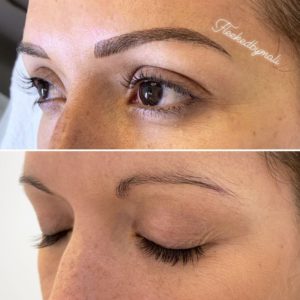What Is Microblading, and Is It Safe During Pregnancy?

Microblading is a semi-permanent procedure that results in natural, fuller-looking brows. But if you’re pregnant or breastfeeding, there’s more you need to know about this trending beauty treatment.
Long gone are the days of super-thin eyebrows tweezed to smithereens. Bushy eyebrows are now in vogue, prompting women to add eyebrow pencils and gels to their shopping carts. But did you know there’s a semi-permanent way to achieve the coveted fuller brow? It’s called microblading, and it’s available at many beauty salons and cosmetic offices across the country.
“Microblading is a semi-permanent tattoo technique performed to create fuller, natural-looking brows,” says Nicole Prochnow, a microblading expert at Ulmer Dermatology in Long Beach, California. Using a small handheld blade of microneedles, a technician will make hair-like strokes on the basal layer of the epidermis (the outermost covering of skin). The embedded pigment looks like individual hairs, and the results last for 1-3 years—unlike a traditional tattoo, which is completely permanent since larger quantities of ink are inserted deeper into the skin.
According to Prochnow, “microblading enhances your natural features by creating a fuller brow look. Whether your brows are overplucked, patchy, missing tails, or you simply want thicker brows, microblading can achieve this while looking natural.” Before you book a microblading appointment, it pays to be prepared. Read on to learn more about the microblading process, and find out whether it’s a safe procedure for everyone.
The Benefits of Microblading
When it comes to beauty, eyebrows are more important than you may think. “Eyebrows are essential because they accentuate the eyes, shape the face, and play a powerful role in the way you communicate yourself to the world,” say Peaches and Masu, co-founders and instructors at SIX+AIT Microblading Studio NYC. Many of their clients get microblading to “enhance or improve their existing brow shape.” They often desire to repair damage from over-plucking or natural hair loss.
Microblading may also be used for medical-related purposes. For example, patients who have lost their brows from chemotherapy can get microblading to restore self-confidence, says Michele Green, M.D., a board-certified dermatologist in New York City. “Microblading can also be done before chemotherapy to avoid losing one of your most important facial features,” she adds.
Peaches and Masu mention three main benefits of microblading:
You’ll have beautiful brows from the moment you wake up. You never need to fill in your eyebrows, which speeds up your morning routine—perfect for busy moms!
Your brows will be sweatproof and waterproof in any weather. You won’t need to worry about pencils and powders melting off your face from the heat—or from your toddler’s messy bath time routine.
Since the microbladed brows are “perfectly symmetrical and professionally designed,” they’ll frame and enhance your face. The pigment also looks natural, so most people won’t know you’ve had microblading done.
Microblading Side Effects
Of course, no beauty treatment is completely free of side effects. Prochnow says some people notice a little flaking and scabbing after the process. There’s also a risk of infection anytime you cut the skin—although chances are minimal if you properly treat the microbladed area. “You want to make sure you keep the area moist with Aquaphor or Vaseline to avoid scabbing,” but avoid wetting the area for about a week afterwards, says Prochnow. “Also avoid picking at any scabs or rubbing the brows during the healing process so you don’t pull out any pigment.”
Peaches and Masu add that some people develop an allergic reaction to some of the products used like latex, pigment, or lidocaine. This could cause temporary swelling, redness, and irritation. The technician should test a small patch test of skin prior to the treatment to ensure there is no negative response, adds Dr. Green.
Also note that you must be 18 years old to receive microblading. If you already have permanent make-up—or if you’d like to cover up a botched microblading job—you should first visit the artist for a consultation.
Microblading During Pregnancy and Breastfeeding
Thanks to frustrating body changes during pregnancy, many women want to indulge in a little self-care. But microblading is not a safe treatment for pregnant women. Here’s why:
“There are no studies on the effects of pigments used in microblading and the chemicals they contain, or how they can affect the fetus,” says Dr. Green. It’s best not to risk the safety of your baby for well-groomed eyebrows.
Numbing creams help ease pain during a microblading session, says Prochnow. These topical anesthetics often contain epinephrine, which may be linked to fetal tachycardia and cardiac problems.
Dr. Green says needles used in microblading are sterile and disposible. However, getting microbladed without proper protocol could result in infections. This includes blood infections, such as like HIV and Hepatitis B, that may harm the fetus.
Pregnancy hormones affect your blood circulation, and they make you more likely to bleed. Excess bleeding may lead to subpar microblading results, since it could fade the pigment or impact its absorption into the skin.
Some pregnant women experience hyperpigmentation (melasma), which is darkening of the skin around the mouth, cheeks, and forehead. This might prompt your technician to choose the wrong pigment color. In turn, your eyebrows might not match your natural skin once the melasma goes away after pregnancy.
Similarly, you’ll likely experience bloating while pregnant. Microbladed brows may look completely different once your bloating subsides after pregnancy, says Dr. Green, and you may not be happy with the result.
Women should also avoid microblading when breastfeeding. That’s because if a mother gets an infection from microblading, she could pass it along to her nursing child. “Most likely, the procedure wouldn’t cause an infection or negative side effects, but for precautionary reasons, you should definitely wait until you are done breastfeeding,” says Prochnow.
The Microblading Technique: How Does it Work?
If you decide to get microblading, the best course of action is visiting a reputable eyebrow boutique, salon, spa, or doctor’s office, says Dr. Green. Research the practice and artist beforehand to ensure you like their work. “See someone who has been certified and trained by a professional microblading instructor/school and is a licensed semi-permanent makeup artist,” says Prochnow. “Also make sure you are in a clean, sterile office that meets all the health requirements for a tattoo procedure.”
Microblading is typically a two-session process, with the sessions spaced six-eight weeks apart. The first session likely involves a consultation, followed by numbing of the skin, drawing the preferred shape, and microblading. Prochnow says to avoid drinking alcohol or taking Advil/Ibuprofen for 24-48 hours before the procedure to avoid excessive bleeding, which can lead to scabbing.
Treated brows last anywhere from 1-3 years, depending on your health, the artist’s technique, and lifestyle factors like sun exposure and activity level. Skincare treatments may also affect longevity—for example, anti-aging products and lasers make pigments fade faster. “If you are happy with your microblading, I recommend getting a touch up every one or one-and-a-half years to keep them full and fresh,” recommends Prochnow. But be wary of getting too many touch-ups in a short period of time, since this can damage the skin and affect results. Peaches and Masu say it’s best to allow the brows to fade as much as possible before your next session.
How Much Does Microblading Cost?
The cost of microblading vary based on location, as well as the experience and demand of the artist. “Microblading can cost anywhere from $300 to $1500 for one session,” advise Peaches and Masu. “We highly recommend choosing your artist based on the quality of results and aesthetically style. There are too many horror stories floating around the Internet to even attempt to choose an artist simply because they are cheaper. This is your face that we are talking about. Microblading, though it fades over time, is considered a permanent procedure, so it’s important to do it right the first time.”
As always, “Wake up, Made Up” with the best Hollywood Florida microblade artist. Call Mali at 941-779-7541
The original article can be found here.
